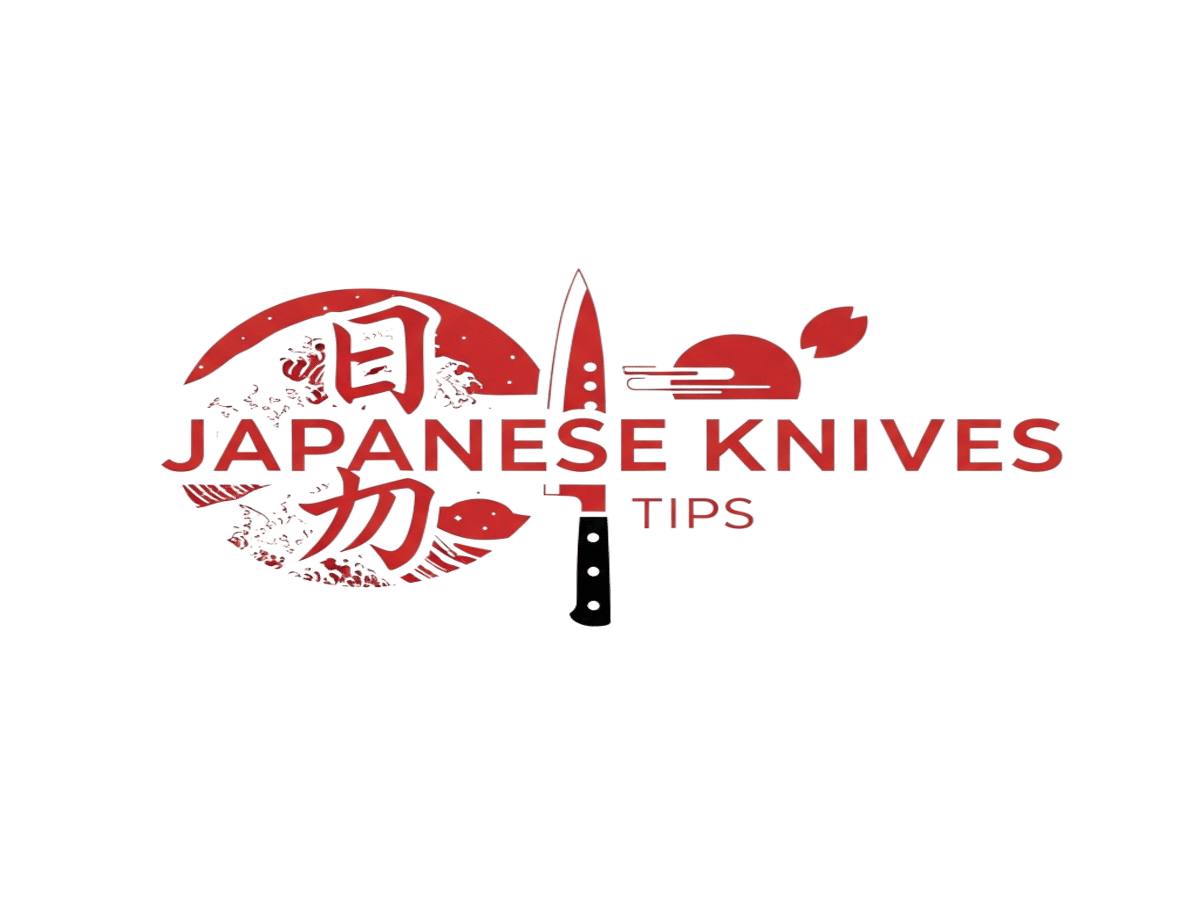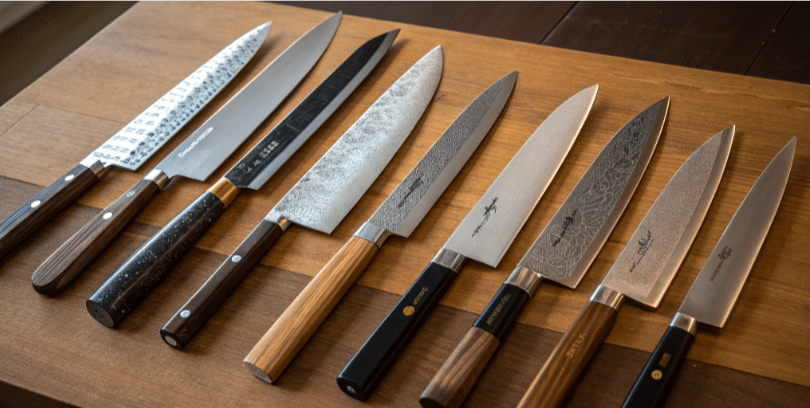Let me tell you, having the right knife in the kitchen makes a big difference. Japan knife types are known for being sharp, light, and easy to use. Whether you’re cooking a quick meal or trying something new, these knives help get the job done cleanly and quickly. There are lots of types out there, each made for different tasks. Knowing a bit about them can make picking one a lot easier. Let’s start with the basics and get you set up with the right knife for your kitchen.
Getting to Know Japanese Knives
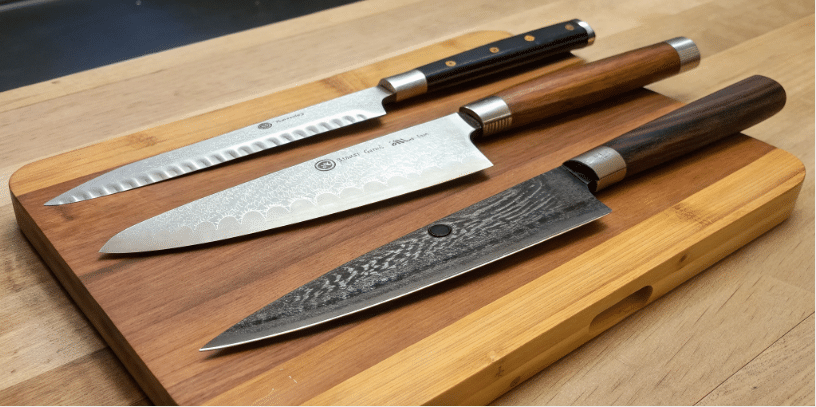
Japanese knives are famous for their sharp blades and careful making. They’re a favorite in kitchens everywhere, from pro chefs to people cooking at home. These knives show off Japan’s long history of making tools that work well and last.
With so many types of Japanese kitchen knives, it can feel tricky to pick the right one. Understanding Japanese names is important, as these names help you identify the knife’s style, purpose, and cultural background. But knowing a bit about the popular knives like the gyuto chef’s knife—which is the Japanese equivalent of a chef’s knife and serves as a versatile, all-purpose kitchen tool for slicing, dicing, and chopping—or the santoku knife helps a lot.
A Quick Look at History
Japanese knife making originates from the art of samurai sword making, with techniques and skills directly passed down through generations. Craftsmen learned from their teachers and passed down their skills for generations. Over time, they created special blade styles, like the single bevel edge found in traditional Japanese knives and the double bevel edge common in Western-style knives, each designed to make cutting easier and cleaner for different tasks.
The process involves heating, hammering, and shaping the steel to get that sharp edge. Today’s makers mix old and new ways to keep the tradition alive while improving the knives. This exceptional craftsmanship, rooted in centuries-old heritage, ensures each Japanese knife is both a precise tool and a work of art.
What Makes These Blades Special?
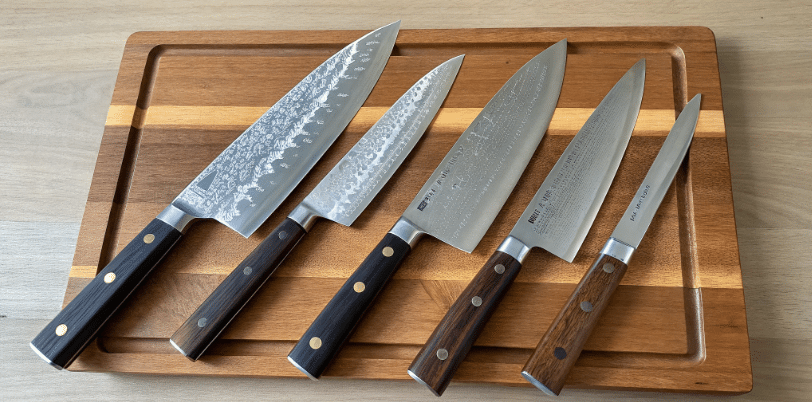
Japanese knives usually have thin blades that are light and easy to handle. These knives often feature a thinner and lighter blade compared to Western knives, which contributes to their precision. This helps with precise cutting without much effort. The high carbon steel used keeps the blade sharp for a long time but needs some care to stop rust. Japanese knives are often made from harder steel, which improves edge retention and sharpness.
Knives like the nakiri have straight edges that make cutting smooth and exact. Its flat edge and straight blade design make it ideal for precision tasks such as dicing vegetables and mincing herbs.
The steel and how the blade is made decide how well the knife works and how long it lasts. These factors influence the knife’s performance, including its cutting edge and suitability for tasks that require precision.
The Importance of Blade Material
Japanese knives are special. The blade material matters. It matters a lot. Most traditional Japanese knives use high carbon steel. Why? It holds a razor sharp edge. It performs like a dream. Professional chefs love them. Home cooks do too. Want to fillet fish? Easy. Need to slice raw fish? Perfect. Chopping vegetables? No problem. High carbon steel handles it all.
High carbon steel blades are amazing. They keep their edge. You won’t sharpen them much. But here’s the thing. They need care. You must clean them. You must dry them. Rust is the enemy. Want something easier? Try softer stainless steel blades. They’re simpler. They resist rust better. Sure, they don’t stay sharp as long. But they’re practical. Busy kitchens love them.
How do you choose? It depends on you. What’s your cooking style? How much maintenance can you handle? Love traditional Japanese knives? Want the sharpest edge for delicate work? High carbon steel wins. Want convenience? Need low maintenance? Softer stainless steel is your friend. Understanding these differences helps. Both home cooks and professional chefs can pick right. The best Japanese knife for their kitchen tasks.
Meet the Main Chef’s Knives
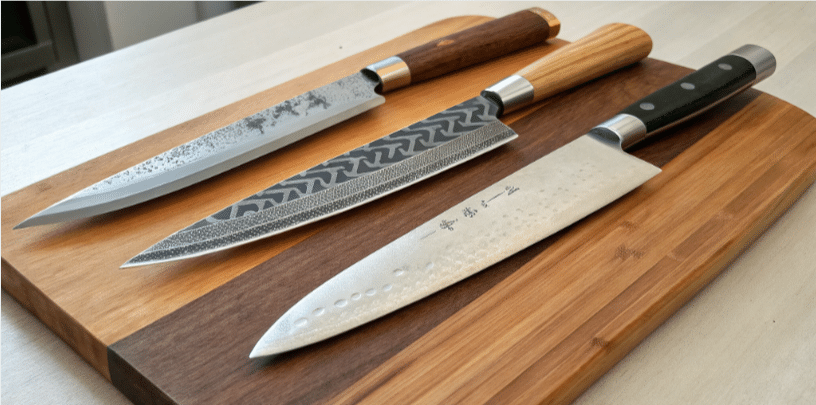
Gyuto Chef’s Knife
The gyuto, also known as the gyuto chef’s knife, is a real all-rounder. It’s like the Japanese version of a Western chef’s knife but usually lighter and thinner. The gyuto is considered the Japanese equivalent of the Western chef’s knife. Its name means “cow sword,” showing it was first made for cutting beef. It is sometimes referred to as a beef knife due to its origins. This knife works well for chopping, slicing, and dicing many foods. Its slender blade makes it a versatile, multi purpose, all purpose knife suitable for slicing meat and a wide range of kitchen tasks.
Santoku Knife
Santoku means “three virtues,” because it’s great for cutting vegetables, meat, and fish. It has a broader blade and a flatter edge than the gyuto. This makes it handy for chopping and scooping food from the board.
Petty Knife
Petty knives are small, versatile kitchen tools perfect for a range of delicate jobs. The petty knife’s narrow blade allows for precise, detailed work such as peeling fruits, trimming herbs, or any task where a big knife feels too much. In Japanese kitchens, the petty knife is often considered a utility knife, ideal for a variety of small, intricate tasks. It’s a handy tool for fine work in the kitchen.
Deba Knife
Deba knives are traditional Japanese knives designed for fish butchery, particularly for filleting and processing fish. As single bevel knives, deba knives feature an asymmetrical edge, allowing for precise, delicate cuts required in Japanese cuisine. The deba is a heavy knife made for tougher jobs like filleting fish and cutting through meat joints. Unlike Western butcher knives or meat cleavers, which are designed for splitting large pieces of meat, bones, and cartilage, the deba’s design focuses on precision and control, making it ideal for fish and poultry rather than heavy-duty butchery. It has a thick spine and a sharp edge that helps with meat preparation but needs careful use to avoid chipping.
Specialty Knives for Specific Tasks
Yanagiba Knife
The Yanagiba is a classic sashimi knife used in Japanese cuisine, designed specifically for slicing raw fish for sushi and sashimi. The name Yanagiba means ‘willow leaf,’ referring to the blade’s long, slender shape that resembles a willow leaf. Its single bevel edge helps make clean cuts with minimal tearing, keeping the fish’s texture just right. The Yanagiba is essential for preparing traditional Japanese cuisine, especially when precision and artistry are required for authentic dishes.
Sujihiki Knife
Sujihiki knives have narrow blades made for slicing cooked meats and fish. They let you cut thin, even slices without crushing the food.
Honesuki Knife
This one has a triangular shape and is perfect for deboning poultry. Its pointed tip helps get around bones without wasting meat.
Usuba Knife
The usuba is a vegetable knife with a straight, single bevel blade. It’s great for precise vegetable cutting and peeling, and is also ideal for dicing vegetables and mincing herbs, making it a versatile tool for vegetable preparation, especially for tricky tasks like making thin slices.
Handles and Comfort
Handles come in many styles, from traditional wood or horn to modern plastic or synthetic materials. A good handle feels comfortable and balanced in your hand, which helps when you’re cutting for a long time. It also makes it easier to handle delicate tasks without slipping.
Taking Care of Your Knife
Japanese knives need some care to stay sharp and last long. Always clean and dry them right after use to avoid rust. Sharpen and hone the blade regularly to keep the edge razor sharp. Store knives safely in a block or on a magnetic strip to protect the blade and your fingers.
Picking the Right Knife for You
Think about what you cook most and how you like to cut. Finding the perfect knife depends on your cooking style, the types of food you prepare, and whether you are a professional chef or a home cook. If you want one knife for many jobs, the gyuto or santoku are solid choices. For smaller, detailed work that may require precision, a petty knife fits well. If you work a lot with fish or meat joints, a deba or yanagiba could be your go-to. Different Japanese knife styles are designed for specific tasks, with some styles excelling at jobs that require precision and fine control.
Look at the blade material, how sharp it stays, and how the handle feels. These things make a big difference in how your knife works and how much you enjoy using it. The perfect knife for a home cook may differ from that of a professional chef, especially for tasks that require precision.
Additional Tips
Want the most from your Japanese knife?
It’s not just about picking the right one.
It’s how you use it.
It’s how you care for it.
Start simple.
Use a stable cutting board.
Always.
Make sure your knife’s straight edge touches the board.
This gives clean cuts.
This gives precise cuts.
Got a santoku knife?
Got a chef’s knife?
Use a gentle rocking motion.
Don’t force the blade.
This protects your knife.
This protects your food.
Storage matters too.
A lot.
Keep your Japanese knife in a knife block.
Or use a magnetic strip.
Why?
This prevents damage to the sharp blade.
After each use, wash your knife.
Dry it right away.
This keeps the blade material good.
This stops rust.
This stops corrosion.
Want your knife to stay sharp?
Want it to work great?
Do regular maintenance.
Hone it.
Sharpen it.
Follow these simple tips.
Choose the right Japanese knife for your needs.
Home cooks can enjoy sharp tools.
Professional chefs can too.
With the right care, your knife works better.
With the right technique, it works better too.
Your Japanese knife will help you cut vegetables.
It will help with delicate tasks.
Everything becomes easier.
Every meal becomes more fun.
Wrapping It Up
Japanese knives bring sharp edges and smart design to your kitchen. Knowing the types and what they do helps you find the knife that fits your cooking style. With a little care, these knives can be your kitchen partner for years, making chopping, slicing, and dicing easier and more precise.
Try one out and see how it changes your cooking game. You might find that the right knife makes all the difference.
FAQs
What makes Japanese knives different from regular kitchen knives?
Japanese knives usually have thinner, lighter blades that let you cut with more precision and less effort. They’re often made from harder steel, which keeps the edge sharp longer. Also, some have a single bevel edge, which means they’re sharpened on one side only, making them great for delicate cuts like slicing raw fish.
Which Japanese knife should I get if I want one knife for most kitchen jobs?
The Gyuto chef’s knife is a solid all-rounder. It’s like the Japanese version of a Western chef’s knife but lighter and thinner. It works well for chopping, slicing, and dicing all kinds of food, from meat to veggies. If you want a versatile knife, this is a great pick.
How do I take care of my Japanese knife so it stays sharp?
Always hand wash and dry your knife right after use to stop rust. Use a proper cutting board like wood or plastic—avoid glass or stone. Regularly hone and sharpen the blade to keep the edge sharp. Store it safely in a knife block or on a magnetic strip to protect the blade and your fingers.
What’s the deal with single bevel vs. double bevel knives?
Single bevel knives are sharpened on just one side, which lets you make super precise cuts, perfect for tasks like filleting fish or cutting sashimi. Double bevel knives are sharpened on both sides and are easier to use for general kitchen work. Both have their place depending on what you’re cooking.
